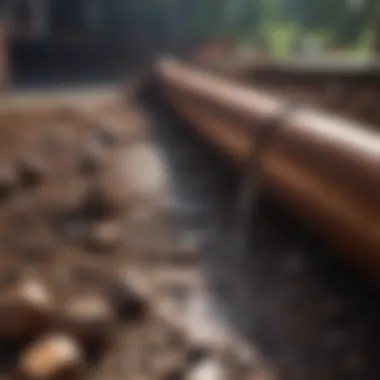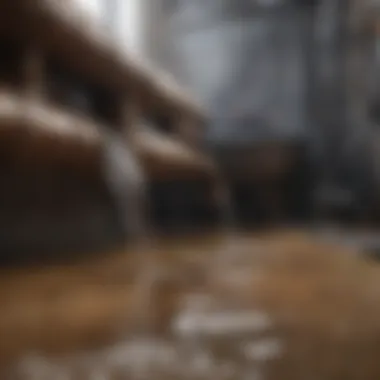Expert Tips for Clearing Blocked Pipes


Intro
Blocked pipes can cause significant distress for homeowners and property managers alike. Understanding how to address this issue effectively is crucial for maintaining a healthy plumbing system. This guide will take you through the common causes of blockages, various techniques for clearing them, necessary tools, and preventive measures to avoid future issues.
Recognizing these elements is vital, as it equips you with the knowledge to handle plumbing challenges efficiently. Whether you are a real estate enthusiast, a seasoned property manager, or simply a homeowner, understanding these concepts will enhance your overall property maintenance expertise.
Causes of Blocked Pipes
Several factors contribute to blocked pipes. Common culprits include:
- Accumulation of debris: Hair, grease, soap scum, and food particles often gather in pipes, leading to clogs.
- Tree roots: Roots can invade underground plumbing, causing significant blockages.
- Faulty installations: Poorly installed plumbing can lead to improper drainage and future clogs.
- Aging pipes: Older pipes may corrode or develop cracks, which can trap debris.
Understanding these causes helps in diagnosing and addressing blockages quickly.
Techniques for Unclogging
Here are several techniques to clear blocked pipes efficiently:
1. Plunger
Using a plunger can be effective for minor blockages:
- Place the plunger over the drain, ensuring a good seal.
- Push down hard, followed by a pull. Repeat this motion to create suction.
2. Baking Soda and Vinegar
This natural method can help dislodge clogs:
- Pour a cup of baking soda down the drain, followed by a cup of vinegar.
- Wait for 30 minutes, then flush with hot water.
3. Drain Snake
A drain snake is useful for tougher clogs:
- Insert the snake into the drain and twist to break up the blockage.
- Pull out any debris caught in the snake.
4. Chemical Cleaners
For persistent blockages, specialty chemical cleaners can be considered, but use them sparingly to avoid pipe damage.
Tools for Clearing Blockages
Having the right tools handy makes addressing blocked pipes easier. Useful tools include:
- Plunger
- Drain snake
- Pipe wrench
- Bucket
- Chemical drain cleaner
Investing in these tools can aid in quick resolutions and reduce the need for professional help.
Preventative Measures
To maintain plumbing health and prevent blockages in the first place, consider these tactics:
- Routine cleaning: Regularly clean drains to remove build-up.
- Installation of screens: Add screens over drains to catch debris before it enters the pipes.
- Limit grease disposal: Avoid pouring grease down the kitchen sink. Instead, let it cool, then dispose of it in the trash.
- Regular inspections: Hire a professional to inspect your plumbing periodically to catch issues before they escalate.
"An ounce of prevention is worth a pound of cure."
This adage holds true in plumbing as well.
Ending
Addressing blocked pipes involves recognizing causes, utilizing the right techniques and tools, and incorporating preventative measures. Understanding these elements allows for effective management of plumbing systems, ensuring they remain functional and efficient. With the information provided, you can tackle blockages with confidence and success.
Understanding Blocked Pipes


Understanding blocked pipes is essential to maintaining a functional plumbing system. Blocked pipes can lead to various plumbing problems, affecting both the efficiency of drainage and the overall health of a property. Without intervention, a small blockage can escalate into a more significant issue, causing water damage or even contamination. Therefore, a thorough comprehension of what constitutes a blocked pipe, its causes, and the signs of blockage is paramount in managing these challenges effectively.
What Are Blocked Pipes?
Blocked pipes refer to plumbing systems that experience reduced flow due to obstructions within the pipe. These obstructions can stem from various sources, including debris, grease, or even structural misalignments. The blockage impedes the normal flow of water, potentially leading to overflow or backflow situations. Recognizing this definition is crucial, as it sets the foundation for understanding the solutions available.
Common Causes of Pipe Blockage
Blocked pipes can arise from multiple factors. Identifying these common causes can help homeowners and property managers take preventative steps.
Accumulation of Debris
Accumulation of debris is a significant contributor to pipe blockage. It often includes substances such as hair, soap scum, and small particles. This type of blockage typically occurs gradually over time as debris builds up in the pipes. Eventually, the passage becomes narrowed, inhibiting water flow. This aspect is crucial in understanding periodic maintenance and cleaning needs to avoid potential issues.
Grease and Fat Build-Up
Grease and fat build-up occurs mainly in kitchen pipes where cooking oils and fat residues are washed down the drain. Over time, these substances solidify and stick to the pipe walls. This build-up can cause severe blockages that are difficult to clear without specialized methods or equipment. Being aware of this cause can encourage property owners to adopt better disposal practices in their kitchens.
Tree Root Intrusion
Tree root intrusion happens when roots from nearby trees or shrubs invade drainage pipes in search of moisture. As these roots enter, they can form blockages that restrict water flow. This intrusion is particularly common in older pipes that may be more vulnerable to such encroachments. Awareness of this issue can lead to regular inspections and better landscaping choices to prevent root growth near pipes.
Pipe Misalignment and Damage
Pipe misalignment and damage can occur due to shifts in the ground, freeze-thaw cycles, or improper installation. When pipes are no longer aligned correctly, water flow can become disrupted, leading to blockages. This type of problem emphasizes the importance of using qualified professionals for installation and repairs.
Foreign Objects
Foreign objects, such as toys, cleaning supplies, or other items accidentally flushed down toilets or sinks, cause blockages in pipes. These can create significant barriers to water flow. Understanding how such objects can cause issues underscores the necessity of careful waste disposal and awareness regarding what should and should not be discarded in drains.
Identifying Blocked Pipes
Determining the presence of a blockage is a crucial first step in addressing plumbing issues. Blocked pipes can lead to significant property damage and health concerns if not treated promptly. Understanding how to identify these blockages can prevent further complications and allows for a more effective response.
Signs of a Blockage
Recognizing the signs of a blockage can save time and resources. Several indicators can alert homeowners and property managers to potential issues before they escalate into more serious problems.
Slow Drainage
Slow drainage is one of the most obvious signs of blocked pipes. This occurs when water does not flow freely through the plumbing system. The defining characteristic of slow drainage is that it takes longer than usual for sinks, tubs, or toilets to empty. Identifying this issue early is essential, as prolonged slow drainage might lead to a complete blockage. It is beneficial to note that different areas in the plumbing might exhibit slow drainage at different times.
The unique feature of slow drainage is that it can sometimes appear gradually, which allows one to dismiss it as a minor issue. However, ignoring it may lead to more serious problems. The advantage of recognizing slow drainage is the ability to take preventative actions earlier in the process, possibly avoiding costly repairs.
Unpleasant Odors
Unpleasant odors emanating from drains are another indicator of blocked pipes. These odors often arise from decomposing food matter or stagnant water trapped in a blocked pipe. This characteristic is notably striking and can easily alert a homeowner to a potential plumbing issue. It serves as a clear indication that something is wrong and needs immediate attention.
The unique aspect of unpleasant odors is that they can linger and spread throughout living spaces. This can lead to discomfort and health concerns. Addressing this aspect promptly can not only remedy the plumbing issue but also improve indoor air quality, which is essential for maintaining a healthy home environment.
Strange Noises
Strange noises emerging from pipes, such as gurgling or bubbling, signify interference in the usual water flow. This can happen when air gets trapped due to a blockage or when debris moves in an obstructed manner. These sounds may differ in intensity, but any unfamiliar noise in plumbing can be considered cause for concern.
The key characteristic here is the irregularity of noises, which may be heard during usage or when water is not actively flowing. The advantage of noting strange noises is that they provide immediate feedback to the user that something is amiss. Identifying this early can help in diagnosing the blockage more accurately before it worsens.
Water Backflow
Water backflow is a serious sign of blockage and can be alarming to encounter. This phenomenon occurs when water flows in the reverse direction due to pressure changes within the plumbing system. Backflow may indicate major blockages farther along in the plumbing, posing a risk to both property and health.
The key feature of backflow is the potential for unsanitary water to re-enter spaces where clean water should flow. This is particularly concerning in residential settings, where it can lead to contamination. The urgency associated with backflow makes it essential to act swiftly. Addressing this issue as soon as it is identified is critical for maintaining the integrity of the plumbing system and ensuring safety.
Tools for Diagnosis


Once these signs of blockage have been identified, various tools can assist in diagnosing the issue more thoroughly. Each tool offers unique insights and methods for exploring the state of the plumbing system, and knowing which tool to use can help expedite the diagnosis.
Plumbing Snake
The plumbing snake is a common tool used for clearing minor blockages. It features a flexible metal wire designed to navigate through pipes, effectively breaking up clogs. The key characteristic of this tool is its ability to reach deep into plumbing systems where blockages may be located. Its effectiveness makes it a popular choice for both DIY homeowners and professionals.
Its unique feature lies in its manual operation; while it requires some effort to use, it is often successful for localized blockages. The disadvantage is that it might not be suited for larger, more persistent clogs that require more advanced methods.
Video Inspection Cameras
Video inspection cameras are advanced tools that allow for an inside look at plumbing systems. These cameras are inserted into the pipes, capturing footage of the interior. The key aspect of this tool is the real-time visual feedback it provides, enabling detailed inspection of the plumbing.
The unique feature of video inspection is its precision; it can accurately identify the location and nature of a blockage. This advanced technology has a disadvantage since it requires a level of expertise to operate a camera effectively and interpret results correctly.
Pressure Test Kits
Pressure test kits measure the pressure within plumbing systems, helping to diagnose blockages. They work by detecting variations in pressure that indicate the presence of clogs. The key characteristic of this tool is its ability to reveal issues that may not be visible through other means.
The unique aspect of pressure testing is that it provides quantitative data regarding system integrity. A disadvantage is that it may require professional knowledge to interpret pressure readings to discern how severe the blockage might be.
Identifying blockages through careful observation and diagnostic tools is essential for preventing further plumbing failures.
DIY Methods for Clearing Blocked Pipes
Blockages in plumbing can be inconvenient and costly. Many homeowners face this problem at one point or another. Such issues often lead to frustration, especially when they disrupt daily activities. In this section, we explore DIY methods for clearing blocked pipes, which offer effective solutions for dealing with clogs without immediately relying on professionals. This saves time and money, but it is essential to approach these methods with caution and understanding.
Using Hot Water
One of the simplest approaches is using hot water. This method is effective for dissolving light blockages, particularly those caused by grease or soap scum. To utilize this method, boil water in a kettle or pot. Once it reaches a rolling boil, slowly pour it down the affected drain.
It is important to repeat this process several times if necessary and follow up by flushing with cold water to help solidify any remaining debris, promoting smoother flow.
Baking Soda and Vinegar Solution
A combination of baking soda and vinegar can effectively clear minor clogs. First, pour half a cup of baking soda down the drain. Next, follow it with half a cup of vinegar. This mixture creates a chemical reaction that can help dislodge debris. After about ten minutes, flush the pipe with hot water to wash away the residue.
This eco-friendly solution works well on slow drains but might not resolve severe blockages. Always ensure that no foreign objects are causing a blockage before use, as it could worsen the issue.
Plumbing Snake Technique
If the clog persists, a plumbing snake may be necessary. This tool is designed to reach deep into the pipes, allowing you to dislodge clogs effectively. Insert the snake into the drain and turn the handle clockwise. As you push the snake further in, it will grab any material causing the blockage. Once you feel resistance, pull back to remove the debris.
It is vital to utilize a snake carefully, as improper usage can lead to pipe damage. Always ensure it is the correct size for the drain.
Mechanical Auger Usage
For more stubborn clogs, a mechanical auger can be useful. Unlike a basic plumbing snake, a mechanical auger is motorized and can reach debris deeper within the pipes. To start, feed the auger cable into the drain and switch on the motor. Allow the auger to drill through the blockage. After completing this, pull back the cable to clear out the debris.
Using a mechanical auger requires extra caution, as it can cause significant damage if misused. Ensure you understand the device's operation before proceeding.
Hydro Jetting Basics
When all else fails, hydro jetting could be an option. This method involves using high-pressure water jets to clear stubborn blockages in pipes. Hydro jetting is usually recommended for severe clogs or routine maintenance.
However, homeowners should consider that this method often requires specialized equipment. It may be best to consult with professionals familiar with hydro jetting to determine if it is suitable for your plumbing system.
In summary, these DIY methods provide various options for clearing blocked pipes. It is essential to adapt the choice of technique based on the severity of the blockage. Each approach has its benefits but also requires attention to detail to prevent further issues.
Professional Solutions for Persistent Blockages
Addressing blocked pipes may sometimes require professional interventions, especially when typical DIY methods do not yield results. This section discusses the importance of turning to professionals, the situations warranting their involvement, and the precautions related to chemical drain solutions.
When to Call a Professional


Recognizing when to engage a professional plumber is crucial. In many cases, DIY attempts can exacerbate the issue or lead to further damage. Signs that signal the need for professional help include:
- Multiple drains in a home exhibiting blockages, suggesting a deeper issue within the plumbing system.
- Persistent odors that do not clear after cleaning methods.
- Repeated backups that occur shortly after being cleared.
- Complete drainage failure, where water cannot exit sinks or toilets.
These indicators can point to more complex problems, such as tree root intrusions, broken pipes, or severe clogs deeper in the system, far beyond the reach of common household tools.
Chemical Drain Cleaners: A Cautionary Approach
Chemical drain cleaners often present a quick-fix solution for clogged pipes. These products can dissolve built-up material, offering immediate relief. However, it is essential to exercise caution. Common issues associated with these cleaners include:
- Pipe Damage: Harsh chemicals can corrode pipes, particularly older ones. Repeated use may lead to costly repairs.
- Health Hazards: Many drain cleaners contain toxic substances that can pose health risks if mishandled. It is critical to use protective gear and ensure proper ventilation when using these products.
- Environmental Impact: Chemical cleaners can adversely affect the environment, contaminating water sources and harming local ecosystems.
For these reasons, if a blockage requires the use of chemical drain cleaners, it is advisable to consult a professional plumber beforehand.
Using a Professional Plumbing Service
Engaging a professional plumbing service has several benefits that outweigh the costs.
- Expertise and Equipment: Licensed plumbers come equipped with advanced tools that can identify and resolve issues effectively. Tools like video inspection cameras allow for thorough diagnosis without invasive procedures.
- Guaranteed Work: Professional services often come with guarantees. This means if the problem persists after their intervention, they will return without further charges.
- Preventative Advice: A skilled plumber will not only fix the current blockage but can provide valuable advice on maintaining a healthy plumbing system moving forward. This can save homeowners from recurring issues and potentially costly repairs in the future.
Preventative Measures to Avoid Future Blockages
Preventing blocked pipes is crucial for maintaining a smooth-functioning plumbing system. By applying strategic measures and routines, homeowners can significantly reduce the likelihood of plumbing issues in the future. It ultimately saves time, money, and stress associated with emergency plumbing repairs. Prevention requires a combination of regular maintenance, proper waste disposal practices, and attention to the way substances enter the plumbing system.
Regular Maintenance Routines
Establishing a regular maintenance routine is one of the best ways to prevent blockages in pipes. This can include checking for leaks, cleaning out drains, and inspecting exposed pipes for any signs of damage. Scheduling annual plumbing inspections by a licensed plumber can also help identify potential issues before they escalate.
- Flush Your System: Run hot water through your drains regularly to help dissolve any buildup before it becomes problematic.
- Clear Visible Debris: Regularly remove hair and debris from shower and sink drains. Using a drain snake can help with more stubborn accumulations.
By adhering to these routines, homeowners can maintain optimal plumbing performance.
Proper Waste Disposal Practices
How you dispose of waste is significant in avoiding pipe blockages. Many people flush non-biodegradable items or pour certain waste down the sink. It is important to understand what can and cannot go down the drain.
- Dispose of Food Scraps in a Trash Bin: Avoid using the sink disposal unit for fibrous or starchy foods that can clump together and create blockages.
- Use a Compactor for Grease: Oil and grease should never go down the drain. Instead, let them cool and solidify before disposing of them in the trash.
Practicing these disposal techniques can prevent major pipeline issues.
Using Drain Screens and Traps
Installing drain screens and traps can offer an added layer of protection against blockages. These devices are relatively inexpensive and can save homeowners considerable costs on plumbing repairs.
- Install Mesh Screens: Place these over drains to catch hair, food particles, and debris before they enter the plumbing system.
- Regularly Clean Traps: Traps can accumulate mess, so check and clean them regularly to ensure that they do their job effectively.
Using these simple devices can make a considerable difference in your plumbing system’s longevity.
Limiting Greasy Waste in Plumbing
One of the leading causes of blocked pipes is the build-up of grease and fat. These substances can fortify when cooled, leading to stubborn blockages.
- Educate All Household Members: Everyone in your home should understand the importance of not pouring grease down the sink.
- Provide Alternative Disposal Methods: A dedicated container for disposing of greasy substances can facilitate good practices in the kitchen.
Putting these practices into action will help keep plumbing systems free from the harmful effects of grease.
Closure
Understanding how to clear blocked pipes is crucial for maintaining a functional plumbing system. This article not only addressed the common causes of blockages but also provided practical solutions ranging from DIY methods to professional services.
Recap of Key Points
- Identifying Cause: Knowing why blockages occur helps to tackle the issue more efficiently. Common causes include debris accumulation, grease buildup, and foreign objects.
- DIY Methods: Several home remedies, like using baking soda and vinegar, can be effective. Other methods, such as using a plumbing snake or hydro jetting, offer further options as self-service solutions.
- Professional Help: When blockages persist, knowing when to call a professional is essential. Only trained plumbers will provide advanced solutions tailored to severe cases.
- Preventative Care: Regular maintenance routines can minimize the risk of future blockages. Proper waste disposal and using screens on drains contribute significantly to optimal pipe health.
Final Thoughts on Maintaining Optimal Pipe Health
Adopting a proactive approach toward plumbing can lead to significant long-term benefits. Homeowners should remain vigilant about what goes down the drain and commit time to routine inspections. Simple measures, like using drain screens and disposing of grease properly, can make a vast difference. These actions not only extend the life of pipes but also save costs associated with major repairs.
"A stitch in time saves nine." Proper care minimizes costly plumbing bills.
By integrating these practices into your home maintenance routine, you can ensure a healthier plumbing system and a more enjoyable living environment.



